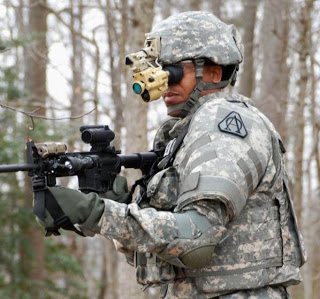DARPA is working on glasses that will endow the user with zoom vision, various forms of nightsight, and act as a heads-up display besides. Perhaps best of all, the proposed kit would also offer “full sphere awareness” – that is, eyes in the back of your head. It is the goals of the DARPA Soldier Centric Imaging via Computational Cameras (SCENICC) project.
All this is to be achieved, according to the specifications for the new project, by the use of “computational cameras”. These are a radical new approach to camera design, which will shift much of the burden of forming images – which is handled optically in today’s cameras – into software.
Darpa unveiled the Soldier Centric Imaging via Computational Cameras effort, or SCENICC
The system, which is purely theoretical at this point, will provide a 360 degree, three-dimensional field of view for soldiers in the field. This optical omniscience is obtained through the use multiple cameras, including images from airborne drones. Soldiers will have real time 10x zoom capabilities and can operate everything via voice commands. As if that weren’t enough, SCENICC employs augmented reality to identify and track targets in a way (we presume) not unlike your garden variety T-800.
Here’s how far advanced SCENICC is compared to bleeding-edge imaging and networking capabilities that the Army is currently developing. Right now, the Army’s asking three different companies — Raytheon, Rockwell Collins and General Dynamics — to build a wearable platform of digital maps, computers and radios, networked with one another. Soldiers would have warzone maps beamed onto helmet-mounted eyepieces.
The system, known as Nett Warrior, needs to weigh less than eight pounds, and it builds on a years-long and ultimately fruitless effort called Land Warrior. (One of the problems with Land Warrior is it was heavy and cumbersome, owing in part to battery weight.) The Army hopes to choose one of the Nett Warrior designs by March.
By the time it’ll actually roll out Nett Warrior after testing, production and deployment — a few years, optimistically — SCENICC will already be hard at work on its replacement. Darpa wants a hands-free zooming function within two years of work on the contract. By year three, the computer-enhanced vision tool needs to be ready. Year four is for 360-degree vision. Then it’s on to development.
The Army is generally hot for combat-ready smartphones to keep soldiers linked up with each other. And the buzz-generating tool for the soldier of the near future is mapping technology, delivered onto a smartphone or some other handheld mobile device, at least judging from this year’s Association of the U.S. Army confab.
The military researchers’ ultimate goal is a miracle lightweight device which would provide all-around spherical vision out to 1000 meters (1100 yards) in high resolution and at a high frame rate across the visual spectrum and well into the infrared bands used by thermal imagers and night sights. However they might be willing to accept as a first step kit which merely improves hugely on that now on offer.
As an example, they give the current US issue M-22 binoculars, which are bulky, heavy and offer limited field-of-view and only 7x magnification. They say:
A preferred solution would operate hands-free, provide similar or better magnification on-demand, while providing FOV equal to that of the unaided eye, and incur [size, weight and power] cost comparable to that of current protective eyewear.
If you liked this article, please give it a quick review on ycombinator or StumbleUpon. Thanks
Featured articles
Ocean Floor Gold and Copper
Ocean Floor Mining Company

Brian Wang is a Futurist Thought Leader and a popular Science blogger with 1 million readers per month. His blog Nextbigfuture.com is ranked #1 Science News Blog. It covers many disruptive technology and trends including Space, Robotics, Artificial Intelligence, Medicine, Anti-aging Biotechnology, and Nanotechnology.
Known for identifying cutting edge technologies, he is currently a Co-Founder of a startup and fundraiser for high potential early-stage companies. He is the Head of Research for Allocations for deep technology investments and an Angel Investor at Space Angels.
A frequent speaker at corporations, he has been a TEDx speaker, a Singularity University speaker and guest at numerous interviews for radio and podcasts. He is open to public speaking and advising engagements.



